Views Along The Decks Of The Queen Mary
When I visited the Queen Mary I found myself again and again just simply
in awe of the ships size and beauty. I think I could never grow tired
of her many decks and rooms. The ship is a real feat of architectural
engineering! Just look at these pictures and remember that this ship
was not built recently, but in the early 1930s in Scotland. The fact
that the ship is still around today simply amazes me. Granted, the
Queen Mary is no longer a ship as she no longer plies the great oceans
of the world as she once did, but visiting her today allows one to learn
the great importance that she has in maritime history and architecture.
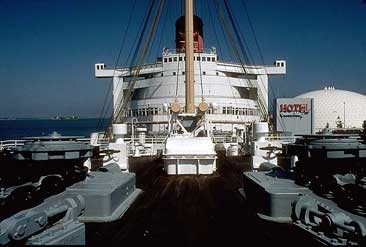
Looking aft from the bow
Here we are standing on the bow looking aft to the forward superstructure.
Directly in front of me are the two massive chains that hold the two main
anchors in place. Each link weighs over 200 pounds. The white box in the
center foreground is one of three cargo hatches that leads down to the cargo
holds in the bowels of the ship. Forward cargo was stored in the bow on F Deck,
G Deck, H Deck and the Tank Top.
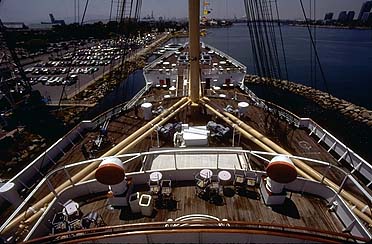
The Bow from Sun Deck
Here we are looking forward from high up on Sun Deck. On the left side
we can see an anti-aircraft gun that was in place while the Queen was a
troop transport in W.W.II. Compare this view to the one taken in 1978
in the first section. I have seen pictures of the Queen Mary in rough
seas where the bow is completely submerged under water, only for a moment
of course. Here we can see the mainmast, and a cargo hatch directly in
front of it. The horizontal beams seen resting at 45 degree angles from
the mainmast are cargo loading booms. The forward
curved portion of Main Deck, where the mainmast is situated, is the Third
Class Promenade area directly outside of the Third Class Garden Lounge. It
was here only that Third Class passengers could be out on deck.
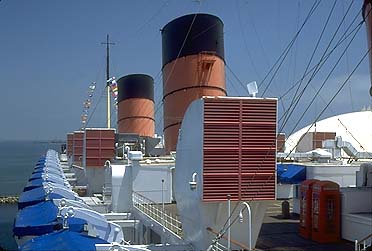
Starboard View from
Docking Bridge
Here we are looking aft from the starboard docking bridge. It is here
where the captain could check the position of the
ship in times of docking and casting off. The huge intake funnels seen
here, now covered with louvers, were put in place to feed air to the
boilers. The two British telephone boxes are sitting idle and do not
contain working telephones.
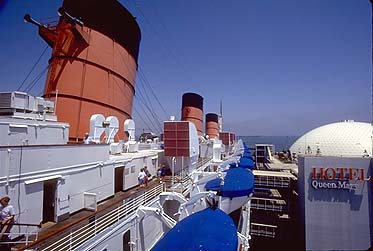
View from port Docking Bridge
This is the same view on the port side of the ship, taken with a wider
lens to include the first funnel. You can see the ships horns on the
first funnel. One is still sounded off at 12, 3, and 6pm daily. If you
were standing where I am standing when it goes of, you would probably
be knocked down. It is loud. Fortunately I was always inside the
ship when they went off. But where ever I was, I heard them! Compare
this view to the one taken from the same location (with a different lens
though) in 1978.
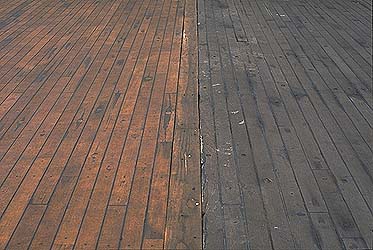
Sun Deck Teak Decking
Restoration
Among current restoration projects aboard the Queen Mary is a very
ambitious one on Sun Deck. They are pulling up the 4 inch thick teak
boards from the steel decks and cutting them in half in to two 2 inch
thick boards. They then plane one of the boards down and seal it with
teak oil to make it waterproof. Instead of fastening the teak decking
directly back on to the steel deck, they are putting down marine plywood
as a base to fasten the decking to. This process ensures the decking will
be aligned in the same position as it was originally. As seen in this
photograph, one can get an idea of what the decks looked like in 1936 on
her maiden voyage! Teak was a hardwood obtained from
Malaysia and other areas which were British colonies before W.W.II. They
were plentiful and cheap in those days. Not any more! (2002 Update: the
decking is finished, however the new teak glow has returned to a dull grey. Not
an easy task to maintain that glow - or cheap!)
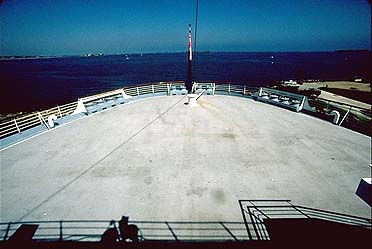
Queen Mary's Stern
At the time I saw this view, I wondered why I couldn't get out to this
area. This is where the aft docking machinery once was, and where Disney
hoped to build an outdoor pool. Those plans were scrapped when they
learned that insufficient structural surveys were done prior to the
demolition, and the stern could not safely support the weight of a
pool. This mentality has unfortunately been the most dominent among the
ships career as a tourist attraction in Long Beach since 1967. Hopefully the
original teak decking which currently lies below this grey covering will be
restored along with the rest of the decking restorations currently being
implemented on the ship. Propellor Park, another place no longer open to the
public, is to the right.








